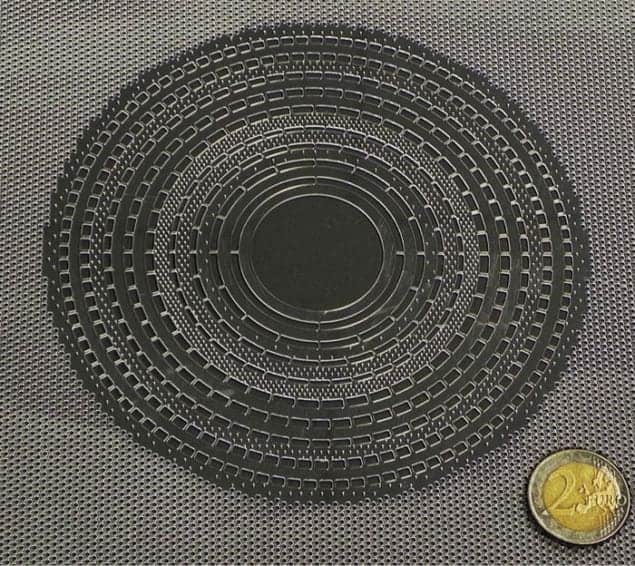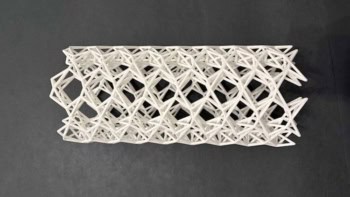
By drilling holes in a piece of PVC and then filling them with soft plastic, scientists in Germany have built a device that can effectively make objects invisible to sound waves. The performance of the acoustic “invisibility cloak” exceeds that of existing electromagnetic devices and could open up new ways of manipulating waves, including the development of shields against seismic waves.
Invisibility cloaks are designed to hide objects from view by causing waves that would otherwise scatter off an object to instead pass around it as if it were not there. Much of the research in this area to date has concentrated on electromagnetic cloaking, and has included the construction of a device that reduces microwave scattering near a copper cylinder and the fabrication of “carpet cloaks” made from the mineral calcite that can hide objects lying on a surface.
The technique of transformation optics that is used to design and build the electromagnetic devices can also be used to develop cloaking against other kinds of waves. In 2009 Stefan Enoch of the Fresnel Institute in Marseille, France, and colleagues put forward a theoretical design for an acoustic cloak made up of concentric rings of materials with differing values of elasticity (Young’s modulus), and now a simplified version of this device has been made.
Concentric rings
The work was done by Martin Wegener, Nicolas Stenger and Manfred Wilhelm of the Karlsruhe Institute of Technology in Germany, who made the cloak from a 15 cm diameter, 1 mm thick disc of polyvinyl chloride (PVC), into which they etched holes arranged in 20 concentric rings. A circular region was left in the centre of the disc just slightly larger than a two-euro coin. This region constituted the item to be hidden. By filling the holes with polydimethylsiloxane (PDMS) and varying the size and spacing between holes from ring to ring, the researchers were able to vary the Young’s modulus across the disc in such a way that elastic (sound) waves within a certain frequency range approaching the disc are bent round the central region and then reform as if there had been no obstacle in the way.
Young’s modulus determines the speed of sound waves through a material, and by varying it across the disc, the team was able to manipulate incoming waves such that their velocity towards the centre of the cloak approaches zero while their velocity around the circumference of the cloak increases. This allowed the waves to travel around the central region and reach the far side of the cloak as quickly as they would have done had there been no cloak. “There is no difference in the time and direction of the emerging wave,” Wegener says. “So the situation is indistinguishable from there being nothing in the way.”
To test their idea, the researchers placed a loudspeaker at one end of the PVC sheet at the centre of which they had carved out the cloak. They then recorded the propagation of sound waves crossing the sheet using stroboscopic lighting and a camera positioned above. The researchers did the same thing with a sheet containing only the central obstacle and found that at frequencies between 200–400 Hz the presence of the cloak allowed the waves to propagate essentially as they would have done without an obstacle in the way, whereas with no cloak the waves were broken up by the obstacle.
Simple and impressive
John Pendry of Imperial College London, who put forward the first design for an electromagnetic invisibility cloak, describes the latest results as “an impressive achievement”. He says that “control of sound has so far lagged behind its optical counterpart” but points out that a number of research groups are now building acoustic cloaks. Ulf Leonhardt of St Andrews University in the UK, who has also designed invisibility cloaks, emphasizes the simplicity of the new device. “I am always amazed how much one can do just by drilling some holes in plastic,” he says.
In an article accompanying the paper describing the work, Ross McPhedran of the University of Sydney in Australia and Alexander Movchan of Liverpool University in the UK say that Wegener’s group has “presented the clearest demonstration of effective cloaking in the literature to this point”. They note that the device not only leaves the passing wave pattern more intact than any other cloak built to date, but also that it covers the greatest bandwidth – one octave, which in terms of electromagnetic waves is more than would be needed to span the whole visible spectrum. They also say that the range of Young’s moduli within the cloak – three orders of magnitude – is “highly advantageous in bending waves round obstacles and would be difficult, if not impossible, to achieve in the corresponding optical situation”. Another advantage they highlight is that the device can be made using precision workshop equipment rather than requiring lithographic printing, as is necessary for many electromagnetic cloaks.
As such, they say, acoustic cloaks “provide an exciting test ground for new techniques to control waves in unprecedented ways” and could be used in applications such as sensing and communications technology. “An obvious possibility much further down the track is in control of seismic waves”, the pair told physicsworld.com.
Steven Cummer of Duke University in the US takes a similar view. “I can imagine that using this one might be able to engineer structures that can reduce vibration in critical locations, and thus might be made lighter or stronger than otherwise,” he says. “And that’s the sort of thing that would be valuable in a lot of different applications.”



